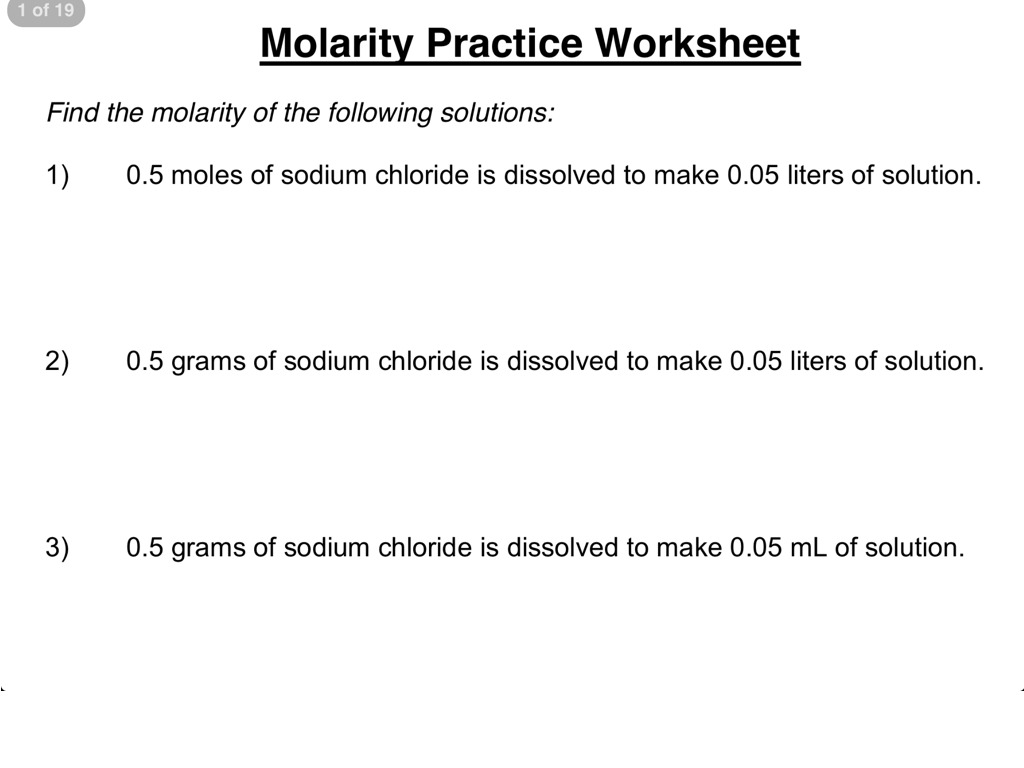Master Molarity: Easy Worksheet Answers Revealed

Mastering the concept of molarity is a vital skill in chemistry, integral for understanding and performing tasks related to solution concentrations. Whether you're a student of chemistry, a budding scientist, or a professional in a lab, grasping molarity enables precise measurements and preparations of chemical solutions. This article will walk you through what molarity is, how to calculate it, and provide an in-depth look at common molarity worksheet questions with their detailed answers.
What is Molarity?

Molarity (M) is defined as the number of moles of solute per liter of solution. It’s a crucial measure of concentration used in chemistry to:
- Measure the strength of a solution
- Standardize solutions for titration
- Quantify the amount of reactant in a given volume of solution
The formula for calculating molarity is:
M = n / V
Where:
- M is the molarity
- n is the number of moles of solute
- V is the volume of the solution in liters
How to Calculate Molarity

To calculate molarity, follow these steps:
- Determine the moles of solute - This can be found by dividing the mass of the solute by its molar mass (n = mass/molar mass).
- Determine the volume of the solution - Make sure the volume is in liters.
- Apply the formula - M = n / V.
Let’s explore these steps through some common worksheet problems:
Common Molarity Worksheet Questions

Here are some typical questions found on molarity worksheets:
Q1: Calculate the molarity of a solution made by dissolving 58.5 grams of NaCl in enough water to make 250 mL of solution.

To solve this:
- Convert volume to liters: 250 mL = 0.250 L
- Calculate moles of NaCl:
- Molar mass of NaCl = 23.0 (Na) + 35.5 (Cl) = 58.5 g/mol
- Moles of NaCl = 58.5 g / 58.5 g/mol = 1.0 mol
- Calculate molarity:
- M = 1.0 mol / 0.250 L = 4.0 M
The molarity of this solution is 4.0 M.
⚗️ Note: Always ensure units are consistent when calculating molarity; volume must be in liters.
Q2: How many grams of NaOH are needed to make 1.5 liters of a 0.5 M solution?

Steps to solve:
- Moles of NaOH needed = Molarity × Volume = 0.5 M × 1.5 L = 0.75 mol
- Molar mass of NaOH = 23.0 (Na) + 16.0 (O) + 1.0 (H) = 40.0 g/mol
- Mass of NaOH = moles × molar mass = 0.75 mol × 40.0 g/mol = 30 g
💡 Note: Be mindful of rounding; here, we’re keeping significant figures consistent with our measurement’s precision.
Q3: Dilution Calculations - How do you prepare 100 mL of a 0.1 M solution from a 2 M stock solution?

Here’s how you could proceed:
- Use the dilution formula: M1V1 = M2V2
- Where M1 = 2 M (initial molarity), V1 = ? (initial volume), M2 = 0.1 M (final molarity), V2 = 0.1 L (final volume)
- Calculate V1:
- V1 = (M2V2) / M1
- V1 = (0.1 M × 0.1 L) / 2 M = 0.005 L = 5 mL
- Add 5 mL of the stock solution to enough solvent to reach a final volume of 100 mL.
Thus, you would take 5 mL of the 2 M stock solution and dilute it to 100 mL.
Why Molarity Matters

Molarity plays a significant role in:
- Chemical Reactions: Knowing the molarity helps in calculating the amount of product formed or reactant consumed.
- Titration: Standard solutions of known molarity are used to determine the concentration of unknown solutions.
- Biological Research: The molarity of buffer solutions affects the environment where reactions occur in living cells.
Moving beyond simple calculations, molarity is used in various applications, from controlling reaction rates to ensuring product quality in industries. Here's how:
Quality Control in Industries

Industries that require precise chemical formulations, such as pharmaceuticals or cleaning products, use molarity to maintain consistency in their products. This involves:
- Ensuring the active ingredient concentrations are within acceptable limits.
- Standardizing the strength of solutions for sterilization processes or cleaning agents.
Environmental Analysis

Environmental chemists measure contaminants in water sources using molarity:
- Assessing the concentration of pollutants like heavy metals or pesticides.
- Evaluating nutrient levels in ecosystems, such as nitrate or phosphate ions.
In conclusion, understanding molarity is essential for accurate chemical practice. It's a fundamental concept that affects calculations, reactions, and the very precision of science. From simple worksheet questions to complex industrial applications, mastering molarity allows for better control over chemical processes, ensuring accurate data, efficient reactions, and safe laboratory practices. Hopefully, this detailed exploration has equipped you with the knowledge to tackle molarity worksheets and grasp its significance in a wider chemical context.
Why is molarity used instead of mass concentration?

+
Molarity accounts for the volume of the solution, making it more practical for many chemical reactions and processes where volume is a more relevant factor than mass.
Can molarity change with temperature?

+
Yes, because the volume of a solution can expand or contract with temperature changes, affecting molarity since it depends on volume. However, the number of moles remains constant, so this affects concentration rather than the total amount of solute.
How does molarity differ from normality?

+
Molarity measures the concentration of a solute in moles per liter, while normality measures it in equivalent weights per liter. Normality accounts for how substances react in solution, which can be useful in acid-base reactions or oxidation-reduction reactions where molarity might not suffice.